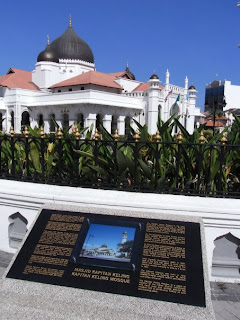Jalan Masjid Kapitan Keling, Penang
Notes for visitors
Visitation hours: Anytime outside prayer times. When you hear the prayer call (azan), it signifies prayer time. You can decide to remain or leave.
Observing Muslim prayer: You can remain in the grounds or mosque and observe how Muslims pray. There is nothing wrong with observing how Muslims pray. There is no need to feel shy, awkward or intimidated and you don't have to run away or feel unwelcome. Just sit quietly and observe.
If you have just come direct from swimming at the nearby beach, please clean yourself at the washrooms and then step inside the mosque. Do not step inside the mosque when your torsos are dirty and smelly.
Slippers & shoes: Leave them outside the building entrance. Do not step inside the mosque with shoes on!!!
Dress code: Decently dressed
Ladies (Muslims & non Muslims): If you are in shorts or short skirts, you can borrow visitation cloaks (free size) at the main entrance inside the mosque.
There is no visitation fee. The mosque is a free place for all.
Please speak to the security at the entrance inside the mosque building if you wish to photograph inside the mosque. Photography is allowed inside and around the mosque outside prayer times. If you are lucky, there may be a tour guide to take you inside the mosque and tend to all your queries.
The greeting in Islam is "Assalamu'alaikum" which means 'peace unto you'. You will receive a reciprocating 'Salam', and just say 'thank you' and smile!!
If by any chance you feel you want to convert to Islam, you can convey your wish to the security guard, tour guide or anyone at the mosque and they will serve you. You do not have to have to change your name when you convert to Islam. Is it your heart that converts, not your name, you are still the same you!!
History
The East India Company acquired Penang in
1786 and renamed it the Prince of Wales Island.
Masjid Kapitan Keling was built in
1801 by a group of Indian Muslims who arrived on the beaches of Penang in
1797. The Indians included the Havildars, Jemadars and Sepoys. The Indian community leader or kapitan was an influential rich merchant,
Kader Mydin Merican @
Cauder Mydeen @
Cauder Mydin @
Cauder Mohiddeen Merican (
1786-1834).
Cauder Mydin's name is inscribed in a monument at GH Penang as a donor in
1879.
Initially, there was a small attap musolla. The mosque had undergone 5 major renovations from
1803 to
1990. A minaret (menara) was added in
1916, before World War I. Part of the mosque (front right prayer corner) was bombed by the Japanese during World War II. The last renovation was performed by an Australian team.
Pitt Street (Lebuh Pitt) was renamed Jalan Masjid Kapitan Keling on
26 December 1989.
The mosque and its surroundings was declared a World Heritage Site (Tapak Warisan Dunia) on
22 November 2008, whose ruling include buildings must not exceed 4 storeys.
Photos from Izaham Musa's Facebook (with permission):
Photos from author's collection, taken on 18-19 November 2008:
View from front entrance (east gate).
Chulia Street entrance (north gate).
Buckingham Street entrance (south gate).
Wet patches indicate site of original well which now lies buried beneath heavy concrete (near north side).
Wudu' pond for men's ablution (south side).
Pond enclosure (south side).
Pump hub - an engineering feat (south side).
Details of pump setup (south side).
Corridor leading to the ladiesroom and wudu' chamber (north side).
Courtyard behind the ladiesroom and wudu' chamber (north side nearest Chulia Street).

Rear garden sandwiched between ancient graves (wall on the left) and corridor to the ladiesroom & wudu' chamber (north gate side). Masjid main building is in the centre background.

Corridor view of the men's wudu' area beyond the buried well (north side).
Tahfiz classrooms (west frontage).
The 6th generation of the Merican clan bore Penang's first Malay doctor, Dr Ali Othman Merican or Dr AO Merican.




















































